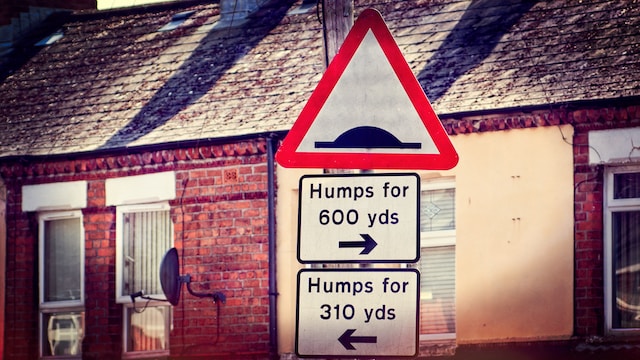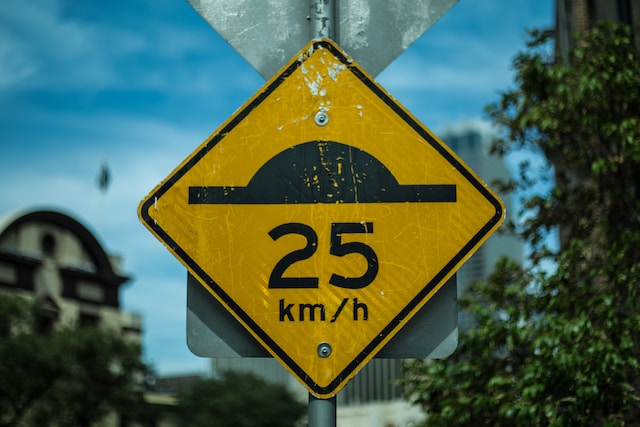When it comes to traffic calming measures, speed humps and speed bumps are both effective solutions. Speed humps are wider and gentler than speed bumps, making them more suitable for larger vehicles or emergency services. On the other hand, speed bumps are narrower but steeper and can be used in parking lots or areas with lower speeds.
What is a speed hump?
(Photo by K. Mitch Hodge on Unsplash )

A speed hump is a raised area on the road designed to slow down traffic. Unlike speed bumps, which are typically more abrupt and steep, speed humps have a gradual incline that spans the width of the roadway. This design allows vehicles to pass over them at a reduced speed without causing as much discomfort or damage.
Speed humps can be made from various materials such as asphalt or rubber depending on their intended use and location. They are often installed in residential neighborhoods, school zones, or other areas where there are concerns about speeding drivers.
One of the main advantages of using speed humps is that they provide an effective way to calm traffic without significantly impacting emergency response times. According to studies, properly placed speed humps can reduce vehicle speeds by 10-15 mph and decrease accidents by up to 50%.
However, not all situations call for speed humps since they may also cause noise pollution and divert traffic into residential streets. Additionally, improper installation of these devices could lead to drainage issues and property damages.
While both types of devices serve similar purposes in reducing speeding incidents in specific locations; choosing between installing either one requires considering crucial factors such as its impact on community members’ well-being and emergency services’ ability to respond promptly.
What is a speed bump?
(Image by hello_world_2022 from Pixabay )

A speed bump is a traffic calming device that is designed to slow down the speed of vehicles. It works by forcing drivers to reduce their speed when driving over it. Speed bumps are typically made from asphalt or concrete, and they come in various sizes and shapes.
The purpose of a speed bump is to increase safety for pedestrians, cyclists, and other motorists by reducing the speed of vehicles on roads where there may be high foot traffic. They are commonly used in parking lots, residential areas, school zones, hospitals, and other areas with low-speed limits.
Speed bumps can vary in height but typically range between 3-4 inches tall. This height ensures that cars must slow down significantly when passing over them. Some newer designs have been created to make them less severe for larger vehicles such as emergency service responders who need to maintain higher speeds.
While effective at slowing down traffic flow through an area they can also create issues like noise pollution and potential damage to cars if not properly maintained or installed correctly.
Speed humps Vs. Speed bumps – Key differences
When it comes to slowing down traffic, speed humps and speed bumps are two common options. While they may seem similar, there are key differences between the two.
Firstly, speed bumps have a sharper incline and decline than speed humps. This means that vehicles have to slow down significantly more when going over a speed bump compared to a speed hump.
Secondly, while both can be made of various materials such as asphalt or concrete, speed humps are generally wider and longer than speed bumps. This allows for a smoother transition for drivers going over them at slower speeds.
The purpose of each is different. Speed bumps are typically used in parking lots or private roads where low speeds are required, whereas speed humps are often used on public roads where speeds need to be reduced gradually without causing damage or discomfort to vehicles.
Knowing the difference between these two options can help you determine which one is best suited for your specific needs.
When to use speed humps or speed bumps
When it comes to traffic calming measures, choosing the right solution can make all the difference. Speed humps and speed bumps are both effective in slowing down traffic, but there are some key differences that should be considered when deciding which one to use.
Speed humps are typically used in areas where drivers need to slow down significantly, such as near schools or hospitals. They are wider than speed bumps and have a more gradual incline and decline. This allows for vehicles to maintain a slower pace while still being able to navigate over them safely.
Speed bumps, on the other hand, are ideal for areas where drivers only need to slow down briefly before speeding up again. For example, they might be used in parking lots or private driveways. Because speed bumps have a sharper angle of incline and decline compared with speed humps, they force drivers to come almost to a complete stop before proceeding forward.
Ultimately, the decision of whether to use speed humps or speed bumps depends on the specific needs of an area. By understanding their differences and assessing what will work best for each location’s context and traffic flow pattern helps create safer roads for everyone involved on it!
How to install speed humps or speed bumps
When it comes to installing speed humps or speed bumps, there are a few key steps you should follow to ensure proper installation and effectiveness.
Firstly, you will need to determine the appropriate location for the speed hump or bump based on factors such as traffic volume and speed. It’s important that the location is clearly marked with signage to alert drivers of its presence.
Next, prepare the surface by cleaning any debris or dirt from the area. This will ensure that the adhesive used during installation properly adheres to the surface.
The actual installation process involves laying down asphalt or concrete over a pre-made mold specifically designed for either a speed hump or bump. The height and length of these devices can vary depending on specific needs and regulations.
Once installed, it’s important to regularly inspect and maintain them for any damage caused by wear and tear or extreme weather conditions.
Proper installation of speed humps or bumps plays an important role in maintaining road safety measures – ensuring both pedestrian safety and driver awareness.
The pros and cons of speed humps and speed bumps
Speed humps and speed bumps are common traffic calming measures. They have both advantages and disadvantages.
One of the advantages of speed humps is that they are more effective at reducing vehicle speeds compared to speed bumps. This is because they are wider and gradual, which means drivers must slow down considerably to avoid them. In contrast, speed bumps can be small enough for some vehicles to drive over without slowing down significantly.
However, one disadvantage of speed humps is that they may affect emergency response times. If an ambulance or fire truck needs to respond quickly, the time taken to navigate a series of speed humps could make all the difference in saving someone’s life.
Another advantage of using speed bumps is their lower cost compared to installing a series of larger speed humps on a street. Speed bumps can also be installed quickly with minimal disruption as long as there aren’t any underground utilities that need moving first.
On the other hand, a disadvantage of using too many or poorly placed speed bumps is increased noise pollution from vehicles driving over them repeatedly throughout the day and night. It could lead people living nearby feeling disturbed by constant noise levels caused by cars passing through.
When deciding whether it’s best to install either type of traffic calming measure in your area you should consider factors such as budget constraints; vehicular volume; pedestrian safety concerns; proximity to schools or residential areas among others before making any decision.
Featured Image By – Makarios Tang on Unsplash








